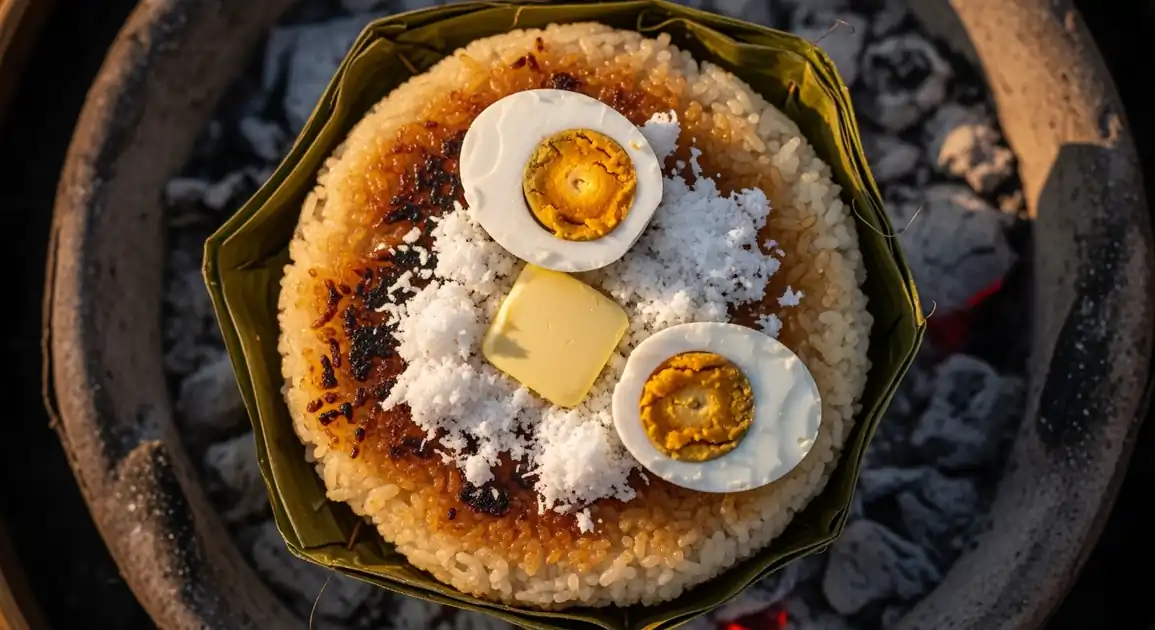Bibingka
Bibingka

Description
Bohol offers bibingka with its own island character, including both rice flour and cassava variations. Bohol bibingka tends toward simplicity and traditional preparation methods, with strong emphasis on quality ingredients rather than elaborate toppings. Visitors can find excellent bibingka in markets, local bakeries, and tourist spots across the island.
Dietary Information
Serving information
Serving style
Typically served wrapped in banana leaf or simple paper wrapping. Tourist spots might serve on plates with utensils.
Quick facts
Traditional market vendors: 5 AM - 12 PM. Tourist area vendors: 8 AM - 6 PM (some until 9 PM in Panglao).
Safety Tips
What to Look For
-
Clay pots with active charcoal cooking
Traditional clay pot cooking with charcoal ensures proper cooking temperatures that kill potential bacteria.
-
Freshly grated coconut topping
Fresh coconut (rather than pre-grated, stored coconut) indicates attention to quality and reduces spoilage risks.
-
Clean banana leaves
Banana leaves should look fresh and clean, as they come in direct contact with the food.
-
Covered ingredients and toppings
Salted eggs, butter, and other toppings should be covered or refrigerated when not in use, especially in hot weather.
-
Vendors cooking in real-time
Bibingka is best eaten fresh; vendors should be actively cooking rather than having a large pre-made stock.
What to avoid
-
Pre-made bibingka sitting for hours
Bibingka loses both quality and safety when left at ambient temperatures for too long, especially in tropical heat.
-
Vendors with unsanitary conditions
Dirty preparation areas, unwashed hands, or poor food handling practices are red flags.
-
Refrigerated bibingka reheated multiple times
Some vendors reheat leftover bibingka; while not necessarily unsafe, it significantly reduces quality and can introduce safety risks.
-
Discolored or dried-out toppings
Toppings like grated coconut or sliced eggs should look fresh; discoloration suggests they've been sitting out too long.
-
Burnt rather than nicely browned exterior
Extremely blackened bibingka may indicate poor temperature control, which could mean uneven cooking internally.
Price information
Price range
Budget tips
- Street vendors and public markets offer the most affordable bibingka (20-40 PHP).
- Tourist destinations like Chocolate Hills or Loboc River areas charge premium prices (50-90 PHP).
- Island hopping tours sometimes include bibingka at higher prices; buying from mainland vendors is more economical.
- Buying directly from local bakers in smaller towns like Jagna or Carmen often offers better value.
Value indicators
- Size relative to price - should be substantial for the cost.
- Proper texture: slightly sticky, moist interior with lightly charred exterior.
- Freshness - should be warm or recently made.
- If paying premium prices, generous toppings should be included.
- Authentic cooking method using banana leaves.
Where to Find This Dish
Tagbilaran Public Market
The provincial capital's main market offers authentic bibingka from local vendors.
Island City Mall vicinity, CPG Avenue
Morning (6 AM - 10 AM)
Loboc Area
Popular with tourists taking river cruises, several food vendors offer local delicacies.
Loboc River Cruise boarding points, Loboc Church
Morning (9 AM - 12 PM), Afternoon (1 PM - 4 PM)
Chocolate Hills Complex
Food stalls at this major tourist destination often include bibingka vendors.
Chocolate Hills viewing deck, Carmen town proper
Morning (8 AM - 11 AM), Afternoon (2 PM - 5 PM)
Panglao Island
Tourist-oriented vendors near beaches and resorts.
Alona Beach, Dumaluan Beach
Morning, Afternoon, Evening (6 PM - 8 PM)
Vendor Tips
- Ask if it's made with rice flour or cassava - both are authentic but taste different.
- Look for vendors using traditional clay pot ovens rather than modern electric ovens.
- In tourist areas, prices are negotiable, especially if buying multiple pieces.
How to Order
Regional Variations
-
Cassava Bibingka
(Bibingka Kamoteng Kahoy)
Distinctly popular in Bohol, using grated cassava instead of rice flour, resulting in a more chewy, sticky texture.
-
Simple Bibingka
(Bibingka Simpleng)
Minimalist version focusing on quality ingredients rather than elaborate toppings, often just with butter and sugar.
-
Coconut Cream Bibingka
(Bibingka sa Gata)
Uses extra coconut cream for richness, a specialty in coastal towns.
-
Pandan Bibingka
(Bibingka Pandan)
Infused with pandan flavor, popular in central Bohol towns like Loboc and Corella.
Cultural context
History
Bibingka has pre-colonial origins, though its exact beginnings are debated. Some food historians believe it may have Indian or Indonesian influences, as similar rice cakes exist across Southeast Asia. The traditional cooking method using banana leaves and dual heat sources has been practiced for centuries. Bibingka became strongly associated with the Filipino Christmas tradition of Simbang Gabi (Night Mass), where vendors would set up outside churches to serve fresh bibingka to mass-goers. In Cebu and Bohol, it evolved with regional touches while maintaining the core cooking techniques and has become a popular treat for tourists seeking authentic Filipino culinary experiences.
Local significance
In Bohol, bibingka represents the island's agricultural heritage, particularly in areas known for rice or cassava cultivation. It's considered both everyday fare and celebratory food during special occasions.
Eating customs
- Boholanos often enjoy bibingka with native coffee or hot chocolate.
- In some areas, cassava bibingka is preferred over rice flour versions.
- Locals typically eat it as mid-morning or afternoon snack rather than dessert.